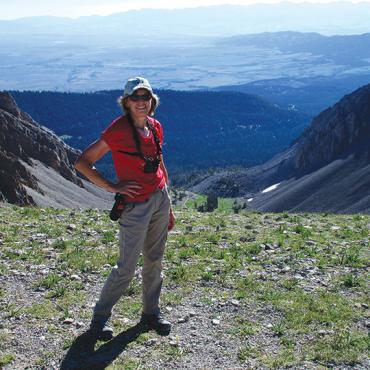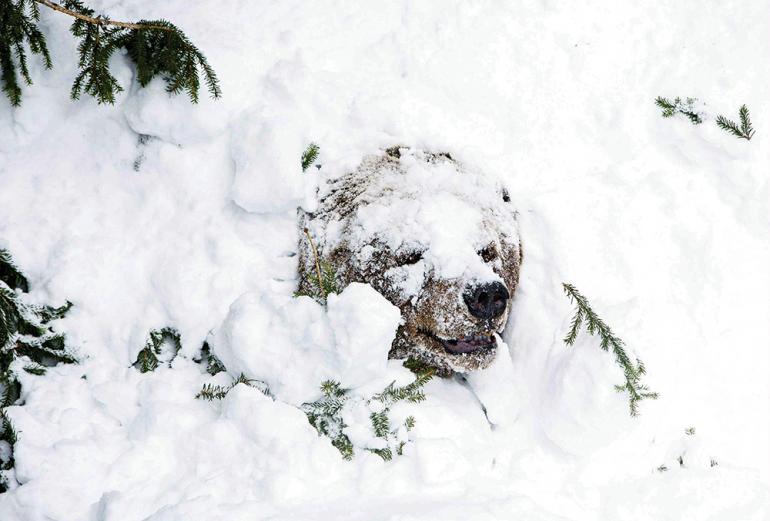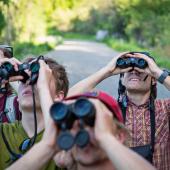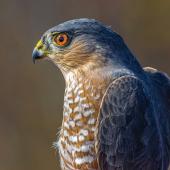Hide, Ride, or Abide to Survive
Breaking down animal behavior in winter.
Montana winters are long, cold, snowy, long, windy, harsh, and long. The transition from fall to winter can be subtle or sudden, but is officially recognized once snow machines outnumber riding mowers, stacks of firewood sprout alongside empty geranium pots, and trees sport icicles on the ends of their deer-ravaged limbs.
Wildlife survive these long, cold, snowy, long, windy, harsh, long winters using a variety of methods. We can break them up into three categories, and while each behavior differs vastly from the others, they all are effective. We’ll see that humans mimic these tendencies to ensure that they, too, will live to see another spring.
Hibernators
Some mammals, including marmots, chipmunks, and bears, respond to food shortages and cold weather by sleeping the winter away in warm dens, aka, hibernating. In fall, a biological urgency known as “hyperphagia” impels the iconic grizzly to forage ravenously for high-nutrient roots, grasses, fresh meat, and carrion. Consuming roughly 30,000 calories a day, grizzlies build up fat reserves sufficient to support a six-month hibernation, during which time they don’t eat or drink. They awaken in spring famished, having lost 15-30% of their bodyweight.
Human hibernators, driven by an inner compulsion some call “footballmania,” cozy up in dens beginning with the first kickoff in September. Consuming massive amounts of carbs and adult beverages, they regularly exceed their recommended daily caloric intake. After months of TV-sports binging, they roll from their man-caves in early spring with fat reserves equal to that lost by their ursine counterparts.
Migrators
Many birds and butterflies begin a long journey south in early fall. The endangered monarch butterfly, for example, may fly as far as 3,000 miles to reach its winter home in Mexico. Monarchs migrate because they are cold-blooded and stand no chance in temps below zero. They face many perils on their long, arduous journey south, including fierce winds, viscous predators, and extreme exhaustion. Their entire journey is guided by instinct.
Montana human migrators, driven by a strong aversion to shoveling snow, as well as a quest for the perfect golf course, travel roughly 1,000 miles in a southwesterly direction. Destinations include, but are not limited to, New Mexico, California, and Arizona. Departure dates coincide with availability of RV rental space or closing on a lease agreement. Though rarely blown off-course, human migrators may encounter unexpected early storms, resulting in time lost indulging in Mexican food and too many frozen margaritas. Another danger is partying too hard with fellow RVers. Their entire journey is guided by GPS.
Adapters
Animals like rabbits, deer, and foxes don’t hibernate or migrate. They are the adapters, and are usually as active in winter as they are in summer. Foxes adapt by growing thick, lush fur and digging warm, cozy dens in which to spend the long, cold, snowy, long, windy, harsh, long winter. Foxes don’t cache food, so they must continue hunting in order to survive. You may notice dainty, cat-like prints along the side of the road on a snowy morning. Pre-dawn, your shy, neighborhood fox is likely hunting voles hiding beneath the snow, or perhaps looking to supplement her diet with comfort food, like feasting on an unsuspecting free-range chicken. Out of necessity, foxes become more solitary during winter.
Human adapters are also known to stay active during these cold, long months. Skiing, snowmobiling, and snowshoeing replace hiking, mountain biking, and trail running. Human adapters exchange polyester for down jackets, baseball caps for beanies, running shoes for faux-fur-lined boots, and sunscreen for thick mittens and face gaiters. Human adapters take comfort in chicken as a winter meal, often in the form of soup (although chili is preferred). Unlike the solitary fox, human adapters spend an inordinate amount of time huddling in neighborhood breweries and bars. Seeking fortitude in bold Scotch ales, they find camaraderie by bitching with their fellow adapters about the long, cold, snowy, long, windy, harsh, long winter.














